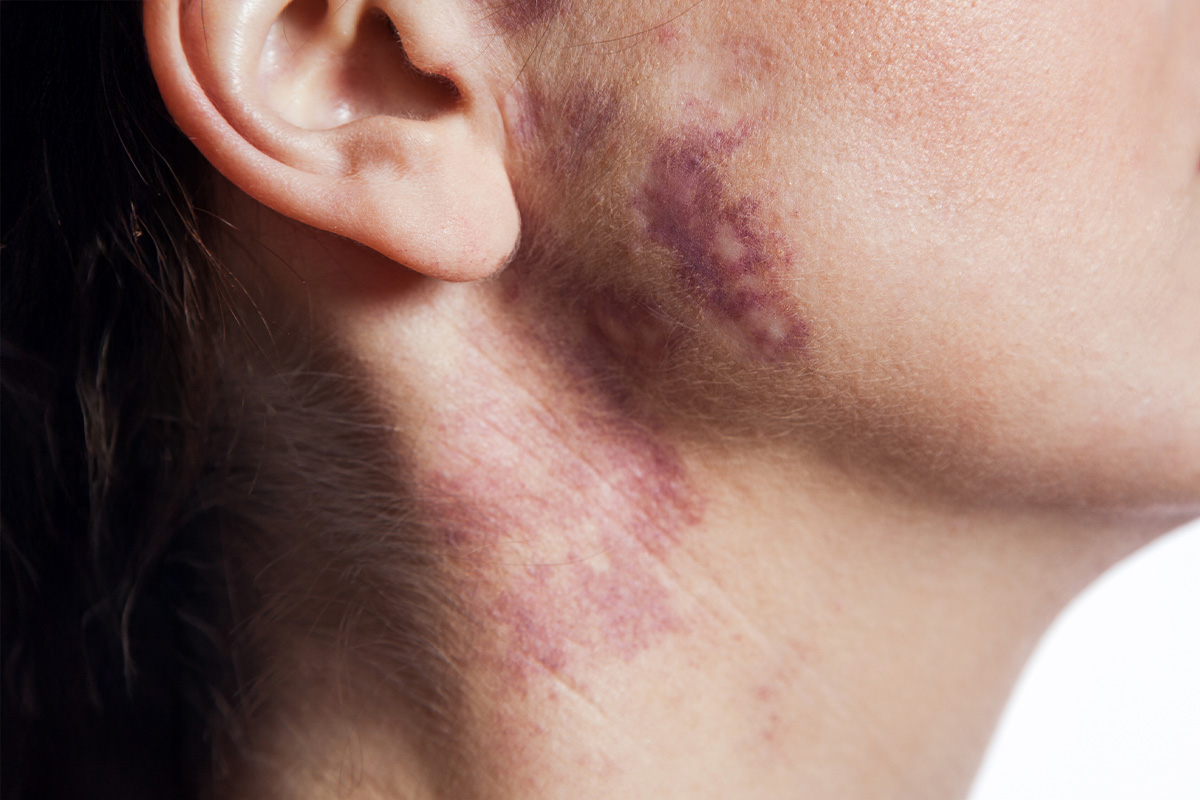Vascular malformations grow steadily over time and may cause swelling, pain, skin discoloration, bleeding, or visible deformities. Led by Dr. Milton Waner and Dr. Teresa O, the Vascular Birthmark Institute specializes in diagnosing and treating these venous malformations in NYC with expert, personalized care.
What Are Vascular Malformations?
Vascular malformations are congenital abnormalities of blood vessels that are present at birth. Unlike vascular tumors, they do not grow rapidly or disappear over time but instead enlarge steadily as the patient grows. They are typically classified based on the type of vessels involved—venous, lymphatic, arteriovenous, venular (such as port wine stains), or mixed, and can cause swelling, pain, bleeding, skin discoloration, or functional impairment. Early diagnosis and expert management are crucial for the best outcomes.

Signs & Symptoms of Vascular Malformations:
- Swelling or enlargement of an area
- Skin discoloration (such as red, blue, or purple patches)
- Pain or tenderness
- Bleeding from the lesion
- Visible veins or deformities
- Functional impairment depending on location (e.g., breathing, eating, movement)
Types of Vascular Malformations
Arteriovenous Malformations
Arteriovenous malformations (AVMs) are fast-flow vascular anomalies where arteries connect directly to veins without the usual intervening capillaries. This causes high-pressure blood flow, which can lead to pain, swelling, bleeding, and even complications like tissue damage or heart strain. AVMs often enlarge over time and typically require a specialized treatment plan.
Lymphatic Malformations
At our center for venous malformations in NYC, we also treat lymphatic malformations—slow-flow anomalies caused by abnormal lymphatic vessels. These typically appear as soft, compressible masses under the skin and can lead to swelling, infection, or fluid leakage. Depending on their size and location, lymphatic malformations may interfere with breathing, eating, or movement and often require a combination of medical and surgical care.
Hereditary Hemorrhagic Telangiectasia (HHT)
Hereditary hemorrhagic telangiectasia (HHT) is a genetic condition characterized by abnormal blood vessel development, leading to frequent nosebleeds, visible small red spots on the skin or mucous membranes, and arteriovenous malformations in organs such as the lungs, liver, or brain. Early diagnosis and coordinated care are essential to prevent serious complications.

Midline Venular Malformation
Midline venular malformations are low-flow vascular anomalies that typically present as faint, flat pink or red patches along the midline of the body, often on the forehead, nose, upper lip, or nape of the neck. While many are harmless and may fade over time, persistent or cosmetically concerning lesions can be evaluated and treated.
Port Wine Stains
Port wine stains are capillary malformations that appear as flat, pink, red, or purple patches on the skin at birth. If left untreated, they typically darken and thicken with age. Port wine stains are most often found on the face, neck, arms, or legs, and early intervention with laser therapy often provides the best long-term cosmetic outcomes.
Vascular Birthmarks
Vascular birthmarks encompass a range of congenital vascular malformations, including capillary, venous, and lymphatic types. They may appear as colored patches, raised lesions, or soft masses, and can vary widely in severity. While some vascular birthmarks remain stable, others may grow or cause complications, making evaluation by a specialist important.
Venous Malformations
Venous malformations are slow-flow vascular anomalies formed by abnormally developed veins. They often appear as soft, compressible blue masses that may swell with activity or position changes and can cause pain, bleeding, clot formation, or cosmetic concerns. At our center for venous malformations in NYC, treatment is tailored to the individual and may include sclerotherapy, laser therapy, and/or surgical removal, depending on the size and severity of the lesion.

Treatments for Vascular Malformations
At the Vascular Birthmark Institute, your treatment begins with a comprehensive evaluation to accurately diagnose the type, location, and severity of your vascular malformation. This often includes a detailed physical exam, imaging studies such as MRI or ultrasound, and sometimes specialized blood tests. Once we understand the specific nature of your condition, we curate a personalized treatment plan to control symptoms, prevent complications, and achieve the best possible cosmetic and functional outcomes.
Laser Treatment
Laser therapy uses highly focused light energy to target abnormal blood vessels without harming the surrounding skin. For vascular malformations like port wine stains or superficial venous lesions, the laser heats and damages the blood vessels, causing them to collapse and eventually be absorbed by your body. This helps reduce discoloration, thickness, and visibility of the malformation over time. Multiple sessions are often needed for the best results.
Surgical Excision
Surgical excision involves physically removing the abnormal vessels or mass through a carefully planned operation. This is often recommended when the malformation causes significant pain, bleeding, disfigurement, or functional problems, and it often involves using advanced reconstructive techniques. In some cases, surgery is combined with sclerotherapy or embolization to shrink the malformation, making removal safer and more effective.
Sclerotherapy
Sclerotherapy is a minimally invasive procedure that treats vascular malformations by injecting a special solution into the abnormal vessels. This solution irritates the vessel walls, causing them to swell, stick together, and eventually scar down. Over time, the treated vessels are naturally absorbed by your body. We offer sclerotherapy for venous malformations in NYC as it can be particularly effective in significantly reducing the size and symptoms.

Embolization
Embolization is a targeted, image-guided procedure in which a doctor uses a catheter to navigate through your blood vessels to the malformation. Once in position, tiny materials such as coils, particles, or medical glue are delivered to block off the abnormal vessels. This reduces blood flow to the malformation, relieving symptoms like pain, bleeding, or heart strain. Embolization is often used alone or as a preparatory step before surgical excision.
Drug Management
In some cases, certain medications can help control symptoms or slow the progression of a vascular malformation. These may include drugs that reduce blood vessel growth, decrease inflammation, or minimize bleeding risks. Drug management is typically used in combination with other therapies based on the type and severity of your malformation.
Combination Therapies
For complex vascular malformations, a combination of treatments often provides the best results. For example, you may first undergo sclerotherapy or embolization to shrink the lesion, followed by surgical excision to remove any remaining abnormal tissue. Dr. Waner and Dr. O work closely together to coordinate a step-by-step treatment strategy customized for you, ensuring you receive the safest and most effective care possible.

Schedule Your Consultation
Vascular Birthmark Institute is a world-renowned specialty practice dedicated to diagnosing and treating vascular malformations. Led by Dr. Milton Waner and Dr. Teresa O, our team offers expert, individualized care using the most advanced medical and surgical techniques available. Whether you need relief from symptoms or want to improve appearance and function, please schedule a consultation today to explore your options to treat venous malformations in NYC.
Contact Vascular Birthmark Institute Today